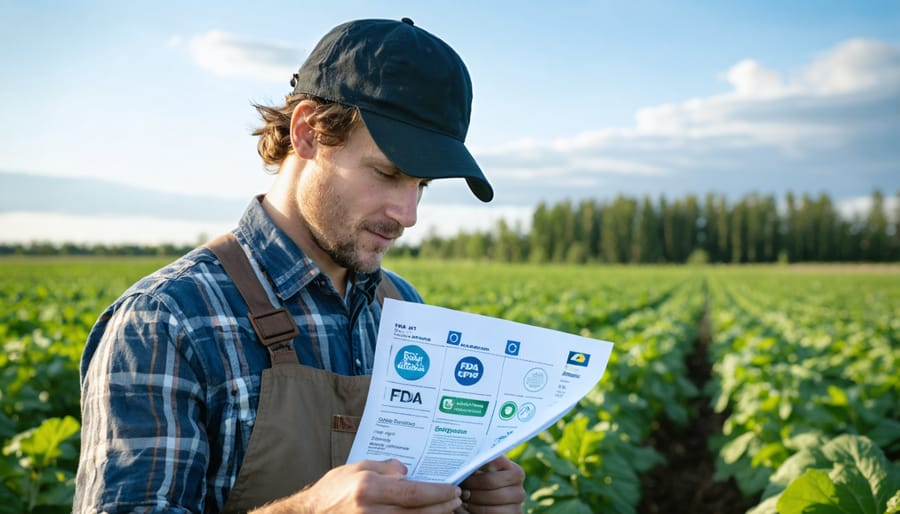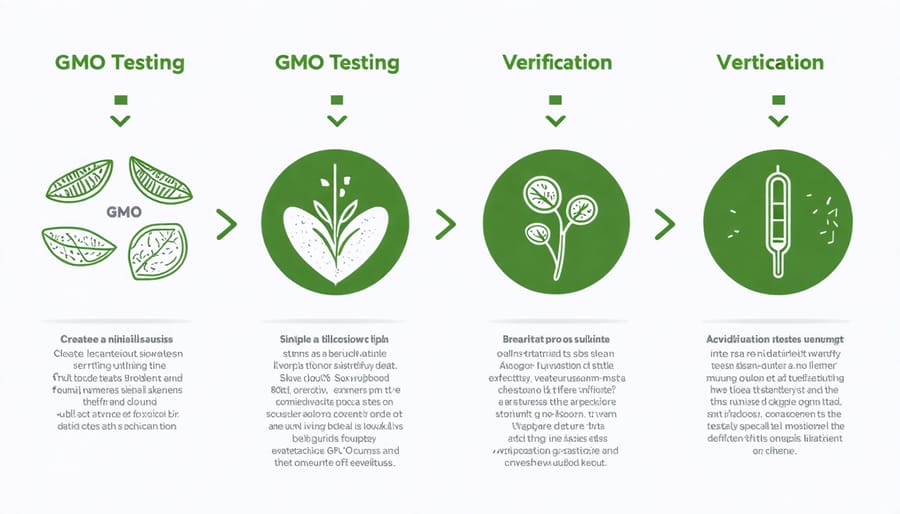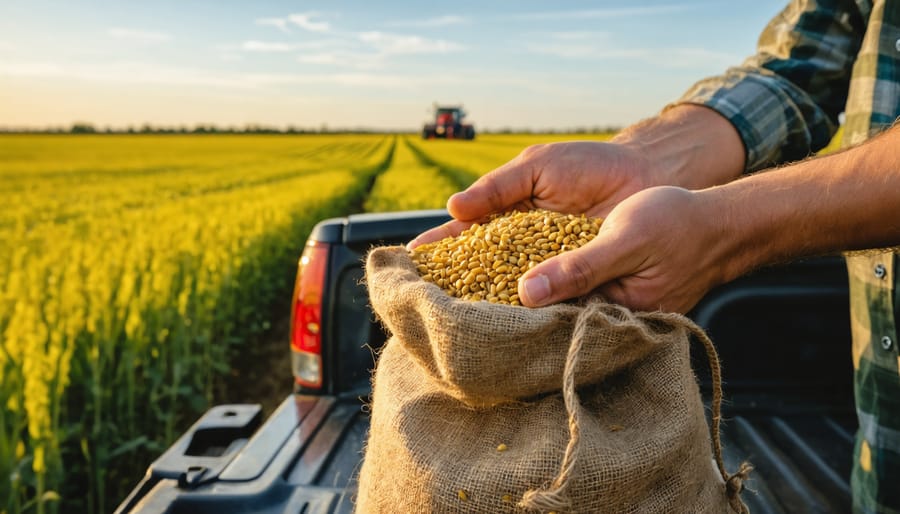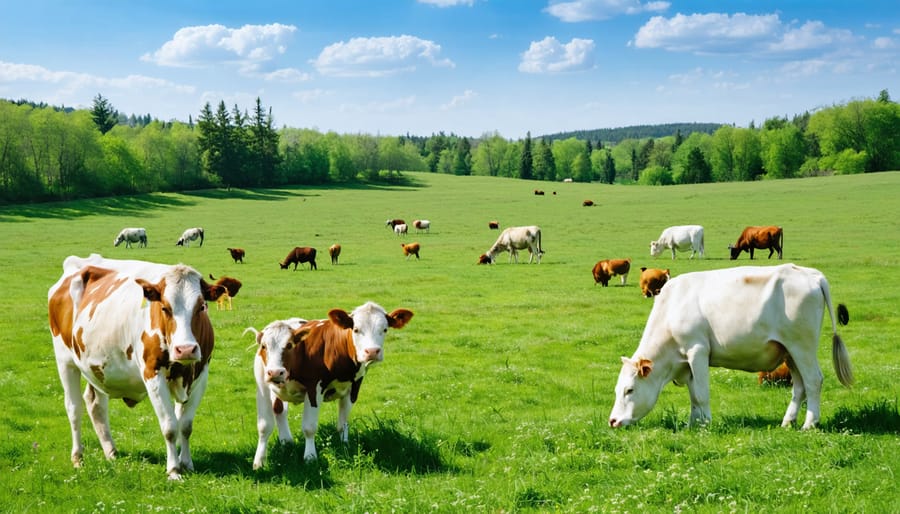Canadian organic farmers navigating FDA GMO regulations face a complex but manageable regulatory landscape that directly impacts cross-border trade and certification requirements. Understanding GMO vs organic farming practices has become essential for Alberta producers exporting to the U.S. market, where FDA oversight intersects with Canadian organic standards.
The FDA’s approach to GMO regulation centers on three core principles: substantial equivalence testing, mandatory pre-market safety assessments, and product labeling requirements. For Canadian organic farmers, these regulations create distinct compliance pathways that affect everything from seed selection to final product documentation. Recent changes to FDA bioengineering disclosure standards have introduced new considerations for organic producers, particularly those managing mixed farming operations or dealing with potential GMO contamination risks.
Despite regulatory complexities, Canadian organic farmers maintain a competitive advantage through established verification systems that align with both FDA requirements and international organic standards. This dual compliance framework positions Alberta producers to confidently navigate U.S. markets while maintaining organic integrity.

How FDA GMO Regulations Influence Canadian Organic Standards
Cross-Border Trade Implications
For Canadian organic farmers, understanding the international trade implications of FDA GMO regulations is crucial for successful cross-border commerce. When exporting organic products to the United States, Canadian farmers must navigate both domestic and FDA requirements, ensuring their products meet the stringent standards of both nations.
The FDA’s GMO labeling requirements directly impact Canadian organic exports, particularly for processed foods and grains. Alberta farmers shipping organic wheat, canola, or pulses to American markets must provide detailed documentation proving their crops are GMO-free and meet FDA verification standards. This includes maintaining comprehensive records of seed sources, field histories, and buffer zones.
Recent harmonization efforts between Canadian and U.S. regulatory bodies have streamlined the verification process, reducing bureaucratic hurdles for organic producers. However, farmers should stay informed about evolving FDA policies, as changes can affect certification requirements and export procedures.
For imports, Canadian farmers bringing in organic inputs or materials from the U.S. must ensure these products comply with both FDA GMO regulations and Canadian organic standards. This dual compliance helps maintain the integrity of organic certification while facilitating smooth cross-border trade.
Regulatory Alignment Challenges
While both the FDA and Canadian Food Inspection Agency (CFIA) maintain strict oversight of GMO products, their approaches differ in several key aspects. Canadian farmers operating near the U.S. border or exporting to American markets need to understand these distinctions to ensure compliance on both sides.
The FDA follows a voluntary consultation process for GMO products, where developers can work with the agency to address safety concerns before market entry. In contrast, Canada’s system requires mandatory pre-market safety assessments through the CFIA and Health Canada, with specific emphasis on the concept of “novel foods.”
Alberta grain producer Sarah Thompson notes, “Understanding both systems is crucial for our export success. We’ve learned to maintain detailed documentation that satisfies both countries’ requirements.” This dual-system awareness has become particularly important as cross-border trade increases.
Notable differences also exist in labeling requirements. While Canada mandates labeling for GMO products with certain exceptions, the FDA’s approach focuses on voluntary labeling unless there are material differences in the food product. For Canadian farmers, this means potentially maintaining different packaging and documentation systems depending on their market destination.
The alignment challenges create additional administrative work but also offer opportunities for farmers to access both markets effectively through proper planning and documentation.
Practical Impact on Alberta’s Organic Farmers

Compliance Requirements
For Canadian farmers navigating FDA GMO regulations, understanding the organic certification requirements and testing protocols is essential. The FDA requires comprehensive documentation of GMO testing methods, including validated PCR (Polymerase Chain Reaction) testing for genetic modifications. Farmers must maintain detailed records of seed sources, testing results, and chain of custody documentation.
Testing requirements include both qualitative and quantitative analyses, with threshold levels set at 0.9% for unintentional GMO presence. Alberta farmers exporting to the U.S. must ensure their testing protocols align with FDA-approved methods and maintain documentation for at least two years. Regular facility inspections and product testing are mandatory, with a minimum of annual verification.
To maintain compliance, farms must implement strict segregation protocols between GMO and non-GMO crops, including dedicated equipment and storage facilities. Buffer zones of at least 8 metres between GMO and non-GMO crops are required, though local conditions may necessitate larger distances.
Farmers must also develop and maintain a written compliance plan that includes standard operating procedures, employee training records, and corrective action protocols. This plan should detail methods for preventing cross-contamination during planting, harvesting, storage, and transportation. Regular staff training on GMO handling protocols and documentation procedures is mandatory to ensure consistent compliance with FDA standards.
Cost Considerations
For Alberta farmers considering organic certification, the financial implications of GMO testing and compliance with FDA regulations require careful consideration. The initial organic certification process typically costs between $1,500 to $3,000 CAD, with annual renewal fees ranging from $750 to $1,500 CAD. These costs vary based on farm size and complexity of operations.
GMO testing, a crucial component of maintaining organic status, adds another layer of expense. Individual tests can range from $200 to $500 CAD per sample, with most farms requiring multiple tests throughout the growing season. Farmers should budget for 3-4 tests annually, depending on crop diversity and proximity to conventional farms.
According to the Alberta Organic Producers Association, implementing buffer zones and maintaining detailed documentation systems can add operational costs of approximately $2,000 to $5,000 CAD annually. However, many farmers report that these investments are offset by premium pricing for certified organic products, with organic crops typically commanding 20-50% higher market prices.
Cost-sharing programs are available through various Canadian agricultural initiatives. The Canadian Agricultural Partnership offers funding that can cover up to 50% of certification costs for eligible farmers. Additionally, group certification options can help smaller operations reduce individual costs through shared resources and collective testing arrangements.
Investment in staff training and quality control systems represents another significant but necessary expense, typically ranging from $1,000 to $2,500 CAD annually.
Sustainable Solutions for Regulatory Compliance
Record-Keeping Best Practices
Maintaining accurate records is crucial for GMO compliance and organic certification. As recommended by organic organizations in Canada, farmers should implement a comprehensive documentation system that tracks all aspects of their operations.
Start by creating detailed logs of seed purchases, including supplier information, genetic modification status, and certification documents. Keep these records for a minimum of five years, as required by FDA regulations. Maintain separate files for conventional and GMO crops to prevent confusion and ensure traceability.
Document all field operations chronologically, including planting dates, crop rotation schedules, and buffer zone measurements. For Alberta farmers working near conventional GMO operations, recording wind patterns and implementing drift prevention measures is particularly important.
Develop a standardized system for batch coding and product tracking. This should include harvest dates, storage locations, and transportation details. Use digital tools when possible to streamline the process, but always maintain backup paper copies.
Regular audits of your record-keeping system help identify gaps and ensure compliance. Consider using pre-made templates available through provincial agricultural offices. Remember to update your documentation procedures whenever regulations change, and train all staff members on proper record-keeping protocols.
Remember, thorough documentation not only satisfies regulatory requirements but also protects your farm’s organic status and builds trust with certification bodies and consumers.
Testing and Verification Methods
The FDA employs rigorous testing protocols to verify the safety and compliance of GMO products. For Canadian farmers dealing with cross-border trade, understanding these verification methods is crucial. The primary testing approach involves event-specific DNA detection, which identifies unique genetic sequences inserted into GMO crops.
Testing laboratories use polymerase chain reaction (PCR) technology to detect modified genetic material with 99.9% accuracy. This method can identify GMO presence in quantities as small as 0.1%, ensuring precise verification for regulatory compliance. Samples are typically collected at multiple points throughout the production chain, from seed to harvest.
For Alberta farmers exporting to the U.S. market, the FDA requires documentation of testing results from approved laboratories. These facilities must follow standardized operating procedures and maintain ISO 17025 accreditation. The verification process includes:
– Protein-based testing using ELISA methods
– DNA-based PCR testing
– Chemical composition analysis
– Nutritional equivalence assessment
– Allergenicity evaluation
Farmers can work with Canadian Food Inspection Agency (CFIA) approved laboratories that align with FDA requirements, streamlining the verification process. Regular monitoring and documentation of test results help maintain compliance and ensure smooth cross-border trade operations.
Local agricultural extension offices in Alberta provide guidance on sample collection and testing procedures, making the verification process more accessible for farmers. Many testing facilities offer rapid turnaround times of 5-7 business days to accommodate harvest schedules and shipping deadlines.

Future Outlook and Adaptation Strategies
Emerging Policy Trends
Recent developments in FDA GMO regulations suggest a shift towards more streamlined approval processes while maintaining robust safety standards. For Canadian farmers, particularly those in Alberta who export to the U.S. market, these emerging trends present both opportunities and considerations.
The FDA is increasingly focusing on a product-based rather than process-based approach to GMO regulation. This means evaluating the final product’s characteristics instead of focusing solely on how it was developed. This shift aligns with Canada’s novel food regulations, potentially simplifying cross-border trade for Alberta farmers.
Industry experts anticipate new guidance on gene-edited crops, which could create additional pathways for innovative agricultural products. The FDA is exploring ways to expedite reviews for crops with familiar genetic modifications while maintaining safety protocols. This could benefit Canadian farmers looking to adopt new crop varieties.
Another significant trend is the increased emphasis on transparency in GMO labeling and traceability. The FDA is working on updating digital disclosure methods and QR code requirements, which may influence how Canadian exporters label their products for the U.S. market.
Sustainability considerations are also becoming more prominent in regulatory discussions. The FDA is examining how GMO regulations can support environmental goals while ensuring food security. This aligns well with Alberta’s agricultural sustainability initiatives and could create new opportunities for environmentally conscious farming practices.
For Alberta farmers, staying informed about these emerging trends is crucial for maintaining market access and adapting operations to meet evolving requirements.
Proactive Compliance Planning
Staying ahead of FDA GMO regulations requires a systematic approach that aligns with both Canadian and U.S. requirements. For Alberta farmers, implementing a proactive compliance strategy starts with establishing strong record-keeping systems. Consider creating digital databases to track seed sources, planting dates, and harvest records, making it easier to demonstrate compliance during inspections.
Regular consultation with agricultural extension services and industry associations can help you anticipate regulatory changes. The Alberta Organic Producers Association offers quarterly updates on GMO regulations and cross-border trading requirements. Consider joining their notification system to receive timely alerts about upcoming changes.
Developing relationships with certified testing laboratories is essential. Having reliable partners for GMO testing can expedite compliance verification and help you respond quickly to new requirements. Many Alberta farmers have found success in forming regional testing cooperatives to share costs and resources.
Create a compliance calendar that includes key dates for regulatory submissions, testing requirements, and renewal deadlines. Schedule annual reviews of your compliance procedures and update them based on new regulations or industry best practices. This approach has helped many Canadian farmers maintain their organic certification while meeting FDA requirements for GMO-free verification.
Consider investing in staff training programs focused on GMO regulations and compliance procedures. Regular training sessions ensure your team understands current requirements and can implement necessary changes efficiently. Document all training activities as part of your compliance records.
Remember to maintain open communication channels with your organic certifier and FDA representatives. Building these relationships can provide valuable insights into upcoming regulatory changes and help you adapt your operations proactively.
As we’ve explored throughout this article, FDA GMO regulations have significant implications for Alberta farmers, particularly those engaged in cross-border trade with the United States. Understanding and adapting to these regulations is crucial for maintaining market access and ensuring compliance on both sides of the border.
For Alberta farmers looking to navigate these requirements effectively, several key action steps emerge. First, maintain detailed documentation of seed sources and growing practices, which will help demonstrate compliance with both Canadian and U.S. regulations. Second, consider joining local agricultural cooperatives or producer groups that share information and resources about regulatory compliance. Third, establish relationships with verification bodies that can help certify your products for various markets.
Looking ahead, staying informed about regulatory changes through Agriculture and Agri-Food Canada’s updates and participating in industry workshops will help you adapt to evolving requirements. Consider working with agricultural extension services, which offer valuable guidance on implementing compliant practices while maintaining profitable operations.
Remember that successful navigation of GMO regulations isn’t just about compliance – it’s about positioning your farm for long-term success in an increasingly complex marketplace. By taking proactive steps now, Alberta farmers can build resilient operations that meet regulatory requirements while maintaining the high standards our agricultural community is known for.
The future of agriculture in Alberta remains bright, with opportunities for both conventional and organic producers to thrive within the regulatory framework. Your commitment to understanding and implementing these requirements helps ensure our province’s continued leadership in sustainable agriculture.










